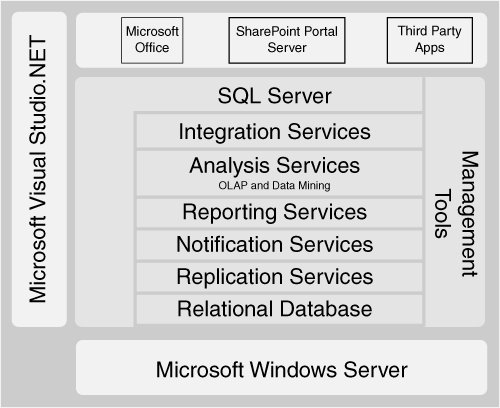SQL Server Components
| SQL Server 2005 consists of a number of integrated components, as shown in Figure 2-1. When you run the SQL Server installation program on a server, you can choose which of these services to install. We focus on those components relevant to a BI solution, but SQL Server also includes all the services required for building all kinds of secure, reliable, and robust data-centric applications. Figure 2-1. SQL Server components Development and Management ToolsSQL Server includes two complementary environments for developing and managing BI solutions. SQL Server Management Studio replaces both Enterprise Manager and Query Analyzer used in SQL Server 2000. SQL Server Management Studio enables you to administer all the aspects of solutions within a single management environment. Administrators can manage many different servers in the same place, including the database engine, Analysis Services, Integration Services, and Reporting Services components. A powerful feature of the Management Studio is that every command that an administrator performs using the tool can also be saved as a script for future use. For developing solutions, BI developers can use the new Business Intelligence Development Studio. This is a single, rich environment for building Analysis Services cubes and data mining structures, Integration Services packages, and for designing reports. BI Development Studio is built on top of the Visual Studio technology, so it integrates well with existing tools such as source control repositories. Deploying ComponentsYou can decide where you would like to install the SQL Server components based on the particular environment into which they are deployed. The installation program makes it easy to pick which services you want to install on a server, and you can configure them at the same time. In a large solution supporting thousands of users with a significantly sized data warehouse, you could decide to have one server running the database engine to store the data warehouse, another server running Analysis Services and Integration Services, and several servers all running Reporting Services. Each of these servers would, of course, need to be licensed for SQL Server, because a single server license does not allow you to run the various components on separate machines. Figure 2-2 shows how these components fit together to create an environment to support your BI solution. Figure 2-2. SQL Server BI architecture |
EAN: 2147483647
Pages: 132
